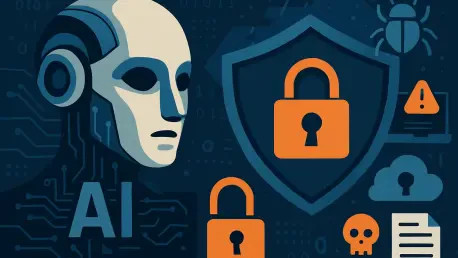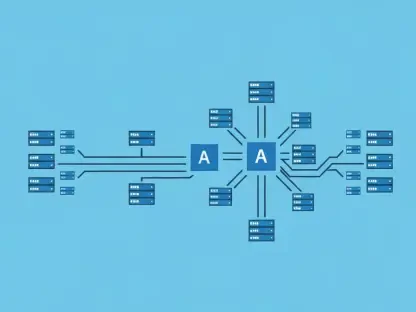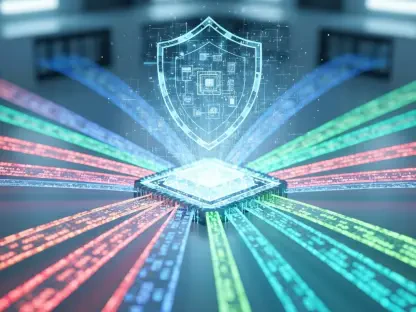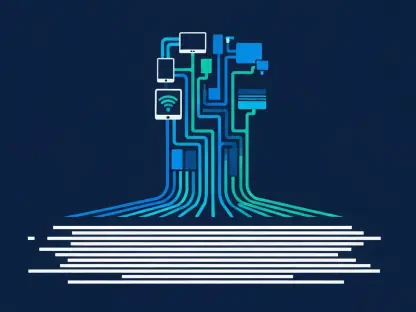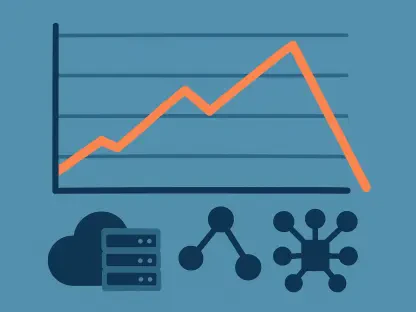The integration of artificial intelligence into software development has sparked a revolution in how code is crafted, promising unprecedented efficiency and innovation, yet it simultaneously unveils a troubling reality of security vulnerabilities that many organizations are unprepared to address. As companies race to leverage AI-powered code generation tools to accelerate their workflows, a recent comprehensive survey by Checkmarx, engaging over 1,500 industry professionals across the globe, reveals a critical mismatch between the adoption of these technologies and the security frameworks meant to protect them. DevSecOps, the practice of embedding security from the earliest stages of the development lifecycle, is faltering under the strain of AI’s rapid rise. This disconnect poses significant risks, as unchecked AI tools introduce blind spots that threaten the integrity of software systems. Exploring these gaps, from governance failures to cultural challenges, is essential to understanding the urgent need for updated security strategies in this evolving landscape.
Unveiling the Governance Void in AI Integration
The scale at which AI is being adopted for code generation is staggering, yet the absence of oversight is equally alarming. According to the survey findings, 34% of organizations now generate more than 60% of their code using AI assistants, a testament to the technology’s transformative potential. However, a mere 18% of these organizations have established formal policies to govern the use of such tools. This glaring governance void means that vast amounts of AI-generated code bypass traditional security checks, slipping into production environments with hidden vulnerabilities. The foundational DevSecOps principle of “shifting left”—integrating security early in the development process—is undermined when there are no guardrails to ensure accountability. Without structured policies, companies are left exposed, gambling on the hope that AI outputs are secure rather than enforcing rigorous standards to validate them, a risky approach in an era where breaches can devastate reputations and finances.
Compounding this issue is the lack of visibility into how AI tools are being utilized across development teams. Many organizations simply do not track which tools are in use or how much of their codebase originates from AI, creating a shadow zone where risks accumulate unnoticed. This blind spot is particularly dangerous because it prevents the application of targeted security measures that could mitigate potential threats. Even in environments where DevSecOps practices are partially implemented, the absence of AI-specific governance renders these efforts incomplete. The survey underscores that years of investment in building secure development pipelines are at stake if organizations fail to adapt their policies to this new reality. Addressing this gap requires not just awareness but a proactive commitment to mapping out AI usage and enforcing rules that align with existing security frameworks, ensuring that innovation does not come at the cost of integrity.
Security Tools Struggling to Keep Pace with AI
Traditional security tools, long relied upon to safeguard code, are proving inadequate in the face of AI-generated outputs, exposing a significant flaw in current DevSecOps strategies. Tools like Static Application Security Testing (SAST) and Software Composition Analysis (SCA) were designed with human-written code in mind, often failing to detect issues in AI-produced code due to its distinct patterns and structures. The survey paints a sobering picture: over 80% of organizations acknowledge deploying vulnerable code to production, a decision often driven by necessity rather than negligence. Even more concerning, 98% of respondents reported experiencing breaches linked to such vulnerabilities within the past year. This widespread issue highlights how existing toolsets are not evolving fast enough to address the nuances of AI, leaving development teams exposed as they prioritize speed over thorough vetting in their race to deliver.
The implications of this technological lag are profound, as it erodes trust in the very systems meant to protect software integrity. Developers, already under pressure to meet aggressive deadlines, find little support from tools that generate excessive false positives or fail to flag genuine threats in AI code. This mismatch not only increases the likelihood of security incidents but also discourages adherence to best practices within DevSecOps frameworks. The survey data suggests that without significant updates to these tools—or the development of new solutions tailored for AI-specific risks—organizations will continue to grapple with preventable breaches. Adapting security mechanisms to recognize and address the unique characteristics of AI-generated code is no longer optional but a critical necessity to prevent vulnerabilities from reaching production environments and causing widespread damage.
Cultural Barriers Hindering Secure Development
Beyond technological shortcomings, cultural dynamics within development teams are amplifying the security risks tied to AI code generation. Many developers, driven by the need to meet tight project timelines, turn to AI tools as a shortcut, often without a deep understanding of the potential pitfalls these tools introduce. The survey reveals a troubling misconception that AI-generated code is inherently safe, a belief that leads to insufficient scrutiny before deployment. This mindset, coupled with the pressure to prioritize speed over security, creates an environment where vulnerabilities are overlooked in the rush to deliver. DevSecOps principles, which advocate for security as a shared responsibility, struggle to take root when such attitudes dominate, undermining efforts to build a robust defense against emerging threats in the development lifecycle.
Adding to this challenge is a lingering distrust in security tools among developers, a sentiment rooted in past experiences with cumbersome systems that bog down workflows with irrelevant alerts. The survey indicates that frustration with false positives and inefficient processes has fostered skepticism, causing many to bypass security protocols altogether when using AI assistants. This resistance is a significant barrier to fostering a security-first culture, as it perpetuates a cycle where risks are ignored rather than addressed. Bridging this cultural divide demands more than just better tools; it requires education on the specific dangers of AI-generated code and a shift in organizational priorities to value security as much as delivery speed. Only by addressing these human factors can DevSecOps evolve to meet the challenges of an AI-driven development landscape, ensuring teams are equipped and motivated to act responsibly.
AI’s Rapid Growth Outstripping Security Measures
The broader trend of AI’s swift proliferation in software development is outpacing the ability of security practices to adapt, creating a widening chasm of risk. Only about half of North American organizations have fully embraced DevSecOps methodologies, and even fewer employ fundamental safeguards like infrastructure-as-code scanning, according to the survey. This inconsistent adoption of security practices leaves a significant portion of the industry vulnerable, particularly as AI tools become more integral to coding workflows. Experts, including Checkmarx’s Eran Kinsbruner, caution that this ungoverned reliance on AI could precipitate catastrophic failures if left unchecked. The emergence of agentic AI—systems capable of autonomously executing tasks—further complicates the landscape by introducing novel attack surfaces that current frameworks are not designed to handle.
This rapid evolution of AI technology demands an equally agile response from security strategies, yet many organizations remain tethered to outdated approaches. The survey highlights a consensus among professionals that without immediate and decisive action, the risks associated with AI in development will only escalate. Businesses are at a crossroads where the benefits of AI-driven efficiency must be weighed against the potential for devastating security incidents. The lack of preparedness for advanced AI systems underscores a systemic issue: security governance has not kept pace with innovation. As AI continues to reshape how software is built, the urgency to update DevSecOps practices becomes undeniable, requiring a forward-thinking approach to anticipate and neutralize threats before they manifest into real-world consequences.
Charting a Path Forward for Secure AI Development
Addressing the security blind spots introduced by AI code generation necessitates a strategic, multi-pronged effort that tackles both technical and cultural dimensions. Eran Kinsbruner advocates for preparing for advanced AI systems, such as agentic AI, by implementing rigorous code review processes and establishing guardrails well before deployment to production environments. This proactive stance aims to curb risks at their source, ensuring that AI outputs are thoroughly vetted for vulnerabilities. Additionally, organizations must prioritize the development of security tools specifically designed to handle the unique patterns of AI-generated code, closing the gap left by traditional solutions like SAST and SCA. By investing in these tailored technologies, companies can better safeguard their development pipelines against emerging threats that evade conventional detection methods.
Equally important is the need to foster a cultural shift within development teams through empowerment and education. Providing developers with targeted training on the risks associated with AI tools can dispel myths about their inherent safety, encouraging more diligent scrutiny of outputs. Integrating security tools seamlessly into existing workflows, while minimizing disruptive alerts, can also rebuild trust in these systems, as highlighted by survey insights. Beyond this, comprehensive governance frameworks are essential, with models like the OWASP AI Vulnerability Scoring System (AIVSS) offering a structured way to assess and mitigate risks. Tailoring policies to distinguish between various code sources—whether legacy, proprietary, or AI-generated—ensures a nuanced approach to security. By combining these strategies, organizations can bridge the current gaps in DevSecOps, balancing the drive for innovation with the imperative to maintain robust protection against evolving digital threats.
